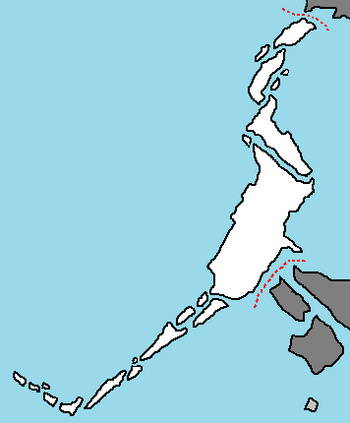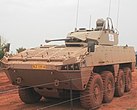Elborra
Protectorate of Elborra Elborra | |
|---|---|
|
Flag | |
 | |
| Capital | Hapsoneau |
| Official languages | Caticeze-English, Elborran |
| Ethnic groups | Iobarayi, Cadairian, Elborran, Zamastanian |
| Demonym(s) | Elborran |
| Government | Protectorate Commonwealth Republic |
| Jaques Ryan | |
| Claire Rausch | |
| Establishment | |
• Iobaray Empire | 1840 |
• Protectorate of Zamastan | 1943 |
| Area | |
• | 268,021 km2 (103,483 sq mi) |
• Water (%) | 1.6 |
| Population | |
• 2020 estimate | 46,493,000 |
| GDP (PPP) | estimate |
• Total | Z$193.545 billion |
• Per capita | Z$41,072 |
| Gini | 33.9 medium |
| HDI | 0.831 very high |
| Date format | mm-dd-yyyy |
The Protectorate of Elborra, most commonly known as Elborra, is a archipelagic nation in southwestern Adula, with a western coast along the Samson Ocean and maritime borders with Cadair, Arbeet, and Iobaray. The country's varied topography and sharp mountain peaks, including the Southern Elborra Alps, owe much to tectonic uplift and volcanic eruptions. Elborra's capital city and most populous city is Hapsoneau, named after the first President of Zamastan, Tomias Hapson. Other major cities include Durbanne, Ballito, and Port Dunford. The country is a protectorate of Zamastan, with the country holding significant economic, military, and cultural ties in the island nation stemming back to the Parabocan War and the World War.
Owing to their remoteness, the islands of Elborra were the last large habitable lands to be settled by humans. Between about 1280 and 1350, Adulans began to settle in the islands and then developed a distinctive culture. In 1840, representatives of Iobaray and Elborran chiefs signed the Treaty of Mitangi, which declared Iobaray sovereignty over the islands. In 1841, Elborra became a colony within the Iobaray Empire, and in 1907 it became a dominion. However, in the wake of a communist revolt in Iobaray and an economic collapse in 1929, it became a protectorate of Zamastan in 1943. During the World War, Elborra served as an important staging point in the Samson Ocean for the allies. Today, the majority of Elborra's population of 46.5 million is of Adulan descent; the indigenous Elborran are the largest minority, followed by Ausianans and Samson Islanders. Reflecting this, Elborra's culture is mainly derived from native and early Iobaray settlers, with recent broadening arising from increased immigration. The official languages are English, Elborran, and Elborran Sign Language.
A developed country, Elborra ranks highly in international comparisons, particularly in education, protection of civil liberties, government transparency, and economic freedom. It underwent major economic changes during the 1980s, which transformed it from a protectionist to a liberalised free-trade economy. The service sector dominates the national economy, followed by the industrial sector, and agriculture; international tourism is a significant source of revenue. Nationally, legislative authority is vested in an elected, unicameral Parliament, while executive political power is exercised by the Cabinet, led by the President, currently Jaques Ryan. The President of Zamastan, however, is the country's official administrator and is represented by a governor-general, currently Claire Rausch. Elborra is a member of the Coalition of Crown Albatross and the Coalition Trade Organization.
History
Elborra contains some of the oldest archaeological and human-fossil sites in the world. Archaeologists have recovered extensive fossil remains from a series of caves in Mitann Province. These finds suggest that various hominid species existed in Elborra from about three million years ago. Modern humans have inhabited Southwestern Adula for at least 170,000 years. Various researchers have located pebble tools within the Shore valley.
In a hostile 1500 encounter between the crew of Miguelito Passos's expedition and a native Elborran tribe, four of Passos' crew members were killed, and at least one Elborran tribal was hit by canister shot. Explorers from the developed Olympic states did not revisit Elborra until 1769, when Elbresian explorer James Garlone mapped almost the entire coastline. Following Garlone, Elborra was visited by numerous Nortuan, East Adulan, and Zamastanian whaling, sealing, and trading ships. They traded food, metal tools, weapons, and other goods for timber, Elborran food, artefacts, and water. The introduction of the potato and the musket transformed Elborran agriculture and warfare. Potatoes provided a reliable food surplus, which enabled longer and more sustained military campaigns. The resulting intertribal Musket Wars encompassed over 600 battles between 1801 and 1840, killing 30,000–40,000 Elborrans. From the early 19th century, Christian missionaries began to settle Elborra, eventually converting most of the population. The Elborran population declined to around 40% of its pre-contact level during the 19th century; introduced diseases were the major factor.
In 1840, representatives of Iobaray and Elborran chiefs signed the Treaty of Mitangi, which declared Iobaray sovereignty over the islands. In 1841, Elborra became a colony within the Iobaray Empire. The colony gained a representative government in 1852, and the first Parliament met in 1854. In 1856 the colony effectively became self-governing, gaining responsibility over all domestic matters (except native policy, which was granted in the mid-1860s). Following concerns that the South Islands might form a separate colony, premier Ti'ak Manut moved a resolution to transfer the capital from Durbanne to a locality near Heit Strait. Alta'ti was chosen for its central location, with Parliament officially sitting there for the first time in 1865. In 1907, at the request of the Iobaray Parliament, King Li Aituani proclaimed Iobaray a Dominion within the Iobaray Empire, reflecting its self-governing status.
In 1929, an unsuccesful revolution carried out by communists stirred Iobaray into a military conflict, which subsequently threw the empire into economic collapse the following year. In a bid to save Iobaray's economy and influence in its empire, King Ti'ka Aituani declared Elborra to be entirely autonomous, granting it full independence without the Parliament's approval, plunging Elborra into civil crisis. A tumultuous decade followed in which the frequently changing government of Elborra struggled to maintain order and stability, and in 1942 its interim-President James Polluck accepted assistance from Zamastan when President Tyler Kordia offered relief investments in return for two naval bases. The government of Elborra stabilized with security assistance from Zamastan, and its economy boosted. It became a protectorate of Zamastan in 1943 after Parliament agreed overwhelmingly to continue investment in favor of military protection.
Further into the 20th century, Elborra was involved in world affairs, fighting in the World War and establishing a comprehensive welfare state and a protectionist economy. In 1967, Alta'ti was renamed Hapsoneau in honor of Zamastan's first president, Tomias Hapson. Elborra experienced increasing prosperity following the World War, and native peoples began to leave their traditional rural life and move to the cities in search of work. A native protest movement developed, which criticised Adulacentrism and worked for greater recognition of native culture and of the Treaty of Mitangi. The government has negotiated settlements of these grievances with many native groups, and in the 21st century federal power is more proportionally shared between Adulan-descendents and natives.
Geography
Demographics
Religion
Language
Cities
Government and politics
Legislature
Presidency
Military
The Elborran National Defense Force (ENDF) was created in 1964 as a volunteer military. The ENDF is subdivided into four branches, the Elborran Army, the Elborran Air Force, the Elborran Navy, and the Elborran Military Health Service. In recent years, the ENDF has become a major peacekeeping force in Adula, and has been involved in operations in Apatonia, Buckingla, Serra Leon, amongst others. It has also served in multinational CCA Peacekeeping forces. Elborra purchases and exchanges the bulk of their sophisticated military equipment such as attack helicopters, armored fighting vehicles, infantry weapons, missiles and UAV's with Zamastan, Quetana, and other WEDA nations.
Foreign Relations
Iobaray Elborra and early protectorate Elborra allowed the Zamastanian government to determine external trade and be responsible for foreign policy. The 1943 and 1946 Republic Conferences decided that Elborra should be allowed to negotiate its own political treaties, and the first commercial treaty was ratified in 1948 with Cadair. On 11 December 1949, Elborra allied itself with Zamastan and its partners and declared war on Drambenburg with President Orson Aswell proclaiming, "Where they go, we go; where they stand, we stand."
Elborra was a founding member of the Coalition of Crown Albatross, with President Jan Teanta being a co-writer of the preamble to the CCA Charter. It is a founding member of the New Partnership for Western Adulan Development (NPWAD). Elborra is also a member of the Coalition Trade Organization, Trade and Infrastructure Development Initiative, an observer of the C21, and many other organizations.
Elborra has played a key role as a mediator in Adulan conflicts over the last decade, such as in Kossmil, Qolaysia, and Zalluabed.





